Generator 101
advertisement
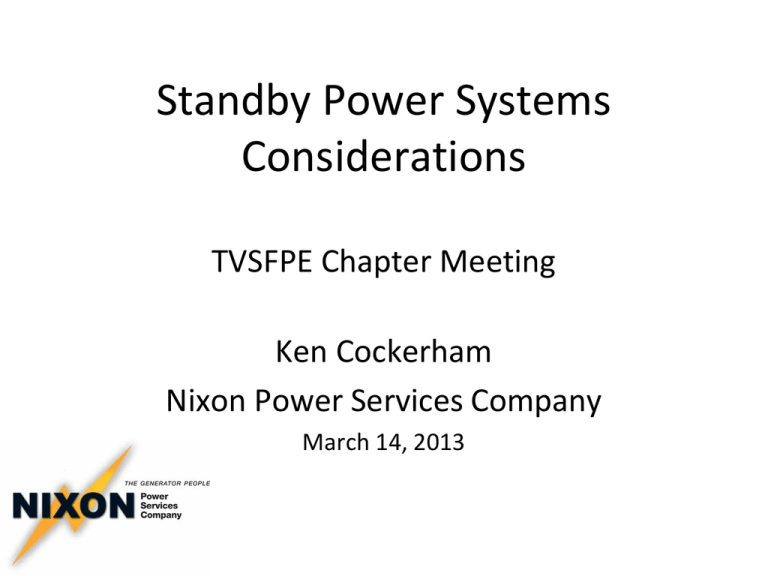
Standby Power Systems Considerations TVSFPE Chapter Meeting Ken Cockerham Nixon Power Services Company March 14, 2013 Basic Engine Generator Set Turbo Charger Exhaust Outlet •Converts Mechanical Energy into Electrical Energy • 1800 RPM Engine Speed Gives 60 Hertz Electrical Output •Engine Power Capability is Rated in Horsepower at 1800 RPM Control Panel Radiator •Engine Drives Alternator, Resulting in Electrical Power Output (AC) Air Intake Filter Engine Alternator Battery Skid Base Sub Base Fuel Tank Output Circuit Breaker(s) Automatic Transfer Switches Utility Source Automatic Transfer Switch (ATS) •Senses presence of both/either power sources ATS-Generator Control Wiring •Starts & Stops Genset •Transfers Load from One Source to the Other ATS Power to the Load The System and How it Works Normal Conditions Utility Source In ‘Normal’ Condition •Load is fed through the ATS from the Utility source •ATS Continually Monitors the Presence of Utility Power ATS-Generator Control Wiring ATS Load is Powered by Utility •Generator is in the Automatic Mode ready to start on command. The engine is being kept warm by a block heater and the starting battery is being kept refreshed by a battery charger. Power Failure Utility Source X When Utility Fails •ATS controller senses failure ATS-Generator Control Wiring •Time delay TDES times out •ATS sends start signal to generator controller ATS •Generator starts and comes up to speed, providing voltage to ATS. No Power to the Load •ATS controller senses availability of generator source and times out TDNE •ATS Contactor transfers from Normal position to Emergency position •The load is now powered by the generator Power Failure Utility Source •ATS controller senses availability of generator source and times out TDNE X When Utility Fails •ATS controller senses failure ATS-Generator Control Wiring •Time delay TDES times out •ATS sends start signal to generator controller •Generator starts and comes up to speed, providing voltage to ATS. ATS No Power to the Load •ATS Contactor transfers from Normal position to Emergency position •The load is now powered by the generator Power Failure Utility Source •ATS controller senses availability of generator source and times out TDNE X When Utility Fails •ATS controller senses failure ATS-Generator Control Wiring •Time delay TDES times out •ATS sends start signal to generator controller •Generator starts and comes up to speed, providing voltage to ATS. ATS No Power to the Load •ATS Contactor transfers from Normal position to Emergency position •The load is now powered by the generator Power Failure Utility Source •ATS controller senses availability of generator source and times out TDNE X When Utility Fails •ATS controller senses failure ATS-Generator Control Wiring •Time delay TDES times out •ATS sends start signal to generator controller •Generator starts and comes up to speed, providing voltage to ATS. ATS No Power to the Load •ATS Contactor transfers from Normal position to Emergency position •The load is now powered by the generator Power Failure Utility Source •ATS controller senses availability of generator source and times out TDNE X When Utility Fails •ATS controller senses failure ATS-Generator Control Wiring •Time delay TDES times out •ATS sends start signal to generator controller •Generator starts and comes up to speed, providing voltage to ATS. ATS No Power to the Load •ATS Contactor transfers from Normal position to Emergency position •The load is now powered by the generator Power Failure Utility Source •ATS controller senses availability of generator source and times out TDNE X When Utility Fails •ATS controller senses failure ATS-Generator Control Wiring •Time delay TDES times out •ATS sends start signal to generator controller •Generator starts and comes up to speed, providing voltage to ATS. ATS Load is Powered by Generator •ATS Contactor transfers from Normal position to Emergency position •The load is now powered by the generator Return to Normal •The load is now powered by the utility Utility Source •Time delay TDES times out When Utility Returns •ATS controller senses availability of utility ATS-Generator Control Wiring •Time delay TDEN times out •ATS Contactor transfers from Emergency position to Normal position causing a momentary blink in power to the load. • ATS sends shutdown signal to generator controller. Engine stays running in cooldown mode ATS •Time delay TDEC times out Load is Powered by Generator •The engine stops and the generator is ready for the next outage Return to Normal •The load is now powered by the utility Utility Source •Time delay TDES times out When Utility Returns •ATS controller senses availability of utility ATS-Generator Control Wiring •Time delay TDEN times out •ATS Contactor transfers from Emergency position to Normal position causing a momentary blink in power to the load. • ATS sends shutdown signal to generator controller. Engine stays running in cooldown mode ATS •Time delay TDEC times out Load is Powered by Generator •The engine stops and the generator is ready for the next outage Return to Normal •The load is now powered by the utility Utility Source •Time delay TDES times out When Utility Returns •ATS controller senses availability of utility ATS-Generator Control Wiring •Time delay TDEN times out •ATS Contactor transfers from Emergency position to Normal position causing a momentary blink in power to the load. • ATS sends shutdown signal to generator controller. Engine stays running in cooldown mode ATS •Time delay TDEC times out Load is Powered by Utility •The engine stops and the generator is ready for the next outage Return to Normal •The load is now powered by the utility Utility Source •Time delay TDES times out When Utility Returns •ATS controller senses availability of utility ATS-Generator Control Wiring •Time delay TDEN times out •ATS Contactor transfers from Emergency position to Normal position causing a momentary blink in power to the load. • ATS sends shutdown signal to generator controller. Engine stays running in cooldown mode ATS •Time delay TDEC times out Load is Powered by Utility •The engine stops and the generator is ready for the next outage Return to Normal •The load is now powered by the utility Utility Source •Time delay TDES times out When Utility Returns •ATS controller senses availability of utility ATS-Generator Control Wiring •Time delay TDEN times out •ATS Contactor transfers from Emergency position to Normal position causing a momentary blink in power to the load. ATS Load is Powered by Utility • ATS sends shutdown signal to generator controller. • Engine stays running in cooldown mode until time delay TDEC times out •The engine stops and the generator is ready for the next outage Return to Normal •The load is now powered by the utility Utility Source •Time delay TDES times out When Utility Returns •ATS controller senses availability of utility ATS-Generator Control Wiring ATS • Engine stays running in cooldown mode until time delay TDEC times out Load is Powered by Utility •The engine stops and the generator is ready for the next outage •Time delay TDEN times out •ATS Contactor transfers from Emergency position to Normal position causing a momentary blink in power to the load. • ATS sends shutdown signal to generator controller. Return to Normal •The load is now powered by the utility Utility Source •Time delay TDES times out When Utility Returns •ATS controller senses availability of utility ATS-Generator Control Wiring ATS • Engine stays running in cooldown mode until time delay TDEC times out Load is Powered by Utility •The engine stops and the generator is ready for the next outage •Time delay TDEN times out •ATS Contactor transfers from Emergency position to Normal position causing a momentary blink in power to the load. • ATS sends shutdown signal to generator controller. Bypass Isolation ATS • For Critical Facilities • Allows ATS to be de-energized and/or removed for service while maintaining power continuity • Allows for manual transfer from Normal to Emergency while in bypass mode (NFPA 110, 6.4.4) Bypass Isolation ATS Interlocked Interlocked To Utility To Generator Set To Load Normal Operation Bypass Isolation ATS Interlocked Interlocked To Utility To Generator Set To Load Emergency Operation Bypass Isolation ATS Interlocked Interlocked To Utility To Generator Set To Load Bypass to Utility Operation Bypass Isolation ATS Interlocked Interlocked To Utility To Generator Set To Load Bypass to Generator Operation Test ”Exercise” Modes • • • • • Scheduled - No Load Scheduled – Loaded Unscheduled – No Load Unscheduled – Loaded NFPA 110, Standard for Emergency and Standby Power Systems (2013 Edition) “Scheduled” is defined as through a programmed exerciser clock Questions – Fuel • Q: How important is fuel testing for gasoline or diesel generators? How often should the fuel be changed out? Does it need to be treated with Sta-bil or some type of fuel treatment? • A1: Fuel testing diesel is very important for reliability and for engine life. • A2: We do not recommend gasoline as a standby generation fuel. Period. • A3: Fuel polishing and additives are available. Their need is identified by testing fuel samples. • Q: What are some of the key elements (water, mold, bacteria, etc.) that should be looked for on a fuel test that would drive one to require that the fuel tank be emptied, cleaned out, and replaced with fresh fuel? • A: The annual fuel sample analysis we recommend checks for 24 Elemental Metals, PenskyMarten Flash Point, Water, Sediment, Bacteria, Fungi, and Mold. Others are available, but this meets ASTM standards per NFPA 110, 8.3.8. In severe cases, fuel is normally removed, tank cleaned, filters replaced, fuel treated and returned (not replaced), fuel train flushed, and engine run under load. Questions – General System Testing • Q: How important is the testing of the automatic transfer switch on a monthly basis? • A: Very important. The ATS is usually the SPF in the system. The closer you can simulate actual outage, the more confidence you can have in the systems reliability. • Q: Does the ATS have to be switched under load? • A: Great question. It’s very difficult to “switch” the ATS except when it is “under load”. The contactor mechanism can be manually articulated from one position to another with an operating handle when it isn’t under load, but the very definition of switching implies transferring load from one source to another. Ergo, if the requirement is to “switch” the ATS, it is “under load”. Questions – General System Testing (cont.) • Q: There always seem to be a lot of discussion about ATS that are provided with a ‘bypass.’ Can an ATS be placed in the ‘bypass’ mode during periodic testing such as monthly or it is required to be tested in the normal mode? • A: NFPA 110 requires the ATS be operated monthly (8.4.6) and immediately following acceptance test or repairs (8.3.2.1). The short answer to the question is “No”. The test of the ATS must occur at the ATS, not the BIS section of a bypass isolation transfer switch. Certainly the generator set can be run under load with the BIS/ATS in the bypass mode. This may be desirable when only the generator set is to be tested. • Q: Can the exhaust gas temperature just be measured with a pyrometer at the surface of the exhaust pipe/muffler? • A: NFPA 110 does not specify “how” the measurement is taken. My personal recommendation is by using an IR gun. It’s important to measure the temperature “downstream” of the turbocharger, and to measure when the unit is under load and up to temperature. Questions – Load Testing • Q: How important is periodic load testing of a generator? Is 30% good enough or should a more substantial load be place on the unit? • A: Recommend 100% rated load test bi-annually on diesels. For diesel engine sets, NFPA 110 (8.4.2)(2) requires monthly 30 minute test at minimum of 30% standby nameplate rating, whereas it doesn’t specify a minimum load for spark ignited engine sets (8.4.2.4). • Q: Can the load test be just the supplied load? If so, is there a minimum % of the name plate rating that the service load should meet? • A: As long as there is sufficient available load to meet the requirements of NFPA 110 (8.4.2) facility load is only ok. Questions – Load Testing (cont.) • Q: Are there significant hazards with using a portable load bank to test with? Do you recommend a permanent disconnect for the load bank or can it just be connected to the generator terminals? • A1: Yes. Electrical hazards associated with ground laid cable, trip hazards, intense heat rejected from the load banks. Portable load bank operations are best left to professionals. Additionally, if stationary generator is to be disconnected from facility load while it is being load banked, a temporary portable generator would need to be connected in its place in anticipation of an unforeseen utility outage. • A2: A permanent load bank connection point with its own breaker is desirable and in some cases essential. NFPA 110 (8.4.2.2) and (8.4.2.4.2) requires that the load bank be “automatically replaced with the emergency loads” (ie disconnected from the load bank and generator power transferred to connected facility load) in the event that utility fails while the generator is in a load bank test. Questions – Load Testing (cont.) • Q: When can a permanent test bank be added to a generator? Does the permanent bank have to be from the manufacturer of the gen set? Are there generic permanent test banks? • A1: A permanent load bank can be added to the system after the fact. It is preferred that it be designed in, specified, and procured along with the new generator set and other EPSS equipment. • A2: The load bank does not necessarily come from the generator set provider, but there are many obvious advantages to procuring it along with the generator set. There are a number of American companies that manufacture and sell load banks. Controls interface after the fact may prove difficult when purchased from multiple sources. • Q: Can you install just one load rod that will provide a 50% load and call it good enough or do you incremental loads? • A: NFPA 110 (8.4.2.3) requires 75% (of nameplate kW rating) load for 1 hour if (8.4.2) is not met. Questions – General System Testing (cont.) • Q: The code (Section 8.4.2) discusses the manufacturers recommend exhaust gas temperatures for the monthly test. Is there a magical temperature that all generators should be tested to or if there a different exhaust gas temperature for every model/brand? Can the exhaust gas temperature be determined with a non-contact IR temperature scanner on the exhaust pipe? • A: Sorry, there is no magical temperature. Each is specified on the manufacturers data sheet included with the operation and service literature. Diesel exhaust is typically in the 950F range. Spark ignited exhaust (natural gas or LP) is typically in the 1200F range. • How should a generator be started when conducting a monthly, annual, or tri-annual test that requires the generator to be tested under loaded conditions? • A: NFPA 110 (8.4.3) Test should be initiated using test switch on ATS or by opening the utility breaker to simulate an outage. Also, (8.4.4) load test is to include complete cold starts. Questions - General • Q: What is the minimum recommended load for a generator? • A: For diesel, 30% of nameplate rating. For spark ignited, there really is no minimum recommendation. • Q: …generators are generally rated in watts or kW’s and the measurement of load would most likely be in amps. Voltage and amps are easy to understand and determine. We need help with how one would determine the efficiency factor for a particular generator or can it be assume that all generators have an efficiency factor of .92 or whatever the number may be? Just trying to figure out how to determine if a particular generator is loaded to at least 30% of it rated capacity. • A: Modern generator sets are designed and rated for a load power factor (PF) of 0.8. The alternator is “overbuilt” enough that it will supply rated true power (kW) even at 0.8 (inductive) load power factor. This means that when powering inductive loads the generator can sustain 125% of the amp rating it would have at full load with unity power factor (PF=1.0, pure resistive load). The load’s PF can be measured with a PF meter. Once PF is known the follow calculations can be made: Single Phase Apparent Power (KVA)=volts X amps/1000 Three Phase Apparent Power (KVA)=volts X amps X 1.73/1000 True Power (kW) = Apparent Power (KVA) X PF Notes Notes
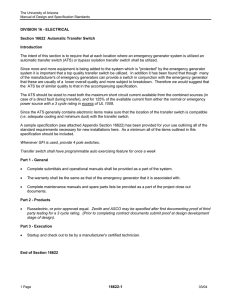
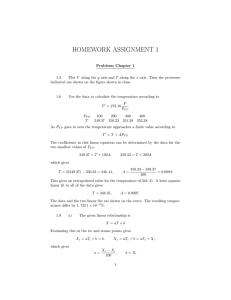
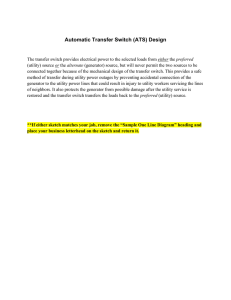
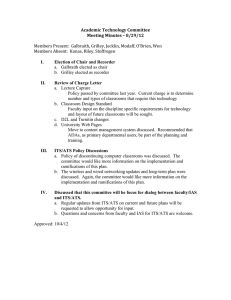
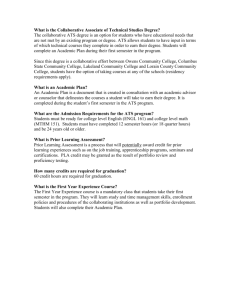
![June 2013 [DOCX 24.38KB]](http://s3.studylib.net/store/data/006990913_1-45414924984da7777020f5c1725fdda9-300x300.png)
